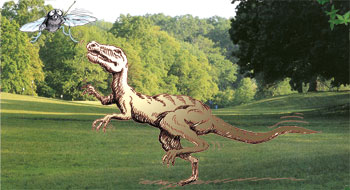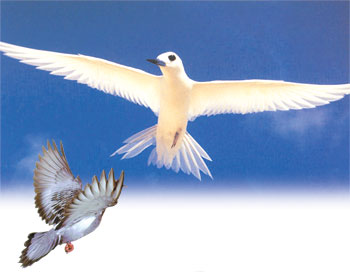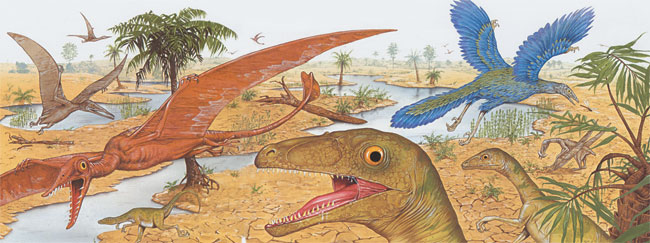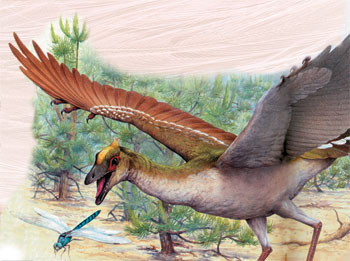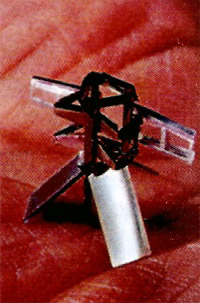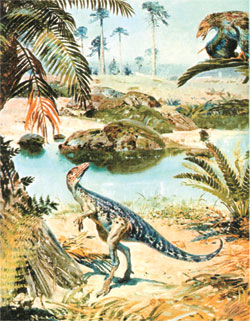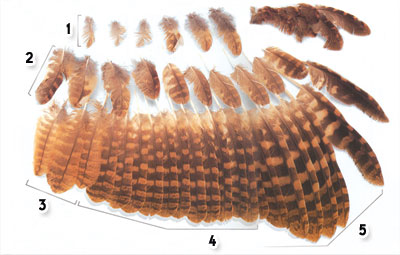Bigotry: The Dark Danger
The Origin of Birds and Flight

DOWNLOAD THE BOOK
CHAPTERS OF THE BOOK
- Foreword
- Introduction
- Evolutionist Scenarios and Dilemmas Regarding the Origin of Flight
- Important Structural Differences Between Dinosaurs and Birds
- Archaeopteryx is an Extinct Species of Bird, Not an Intermediate Form
- The False Fossil Archaeoraptor: An Example of Evolutionist Fanaticism
- Imaginary Dinosaur-Bird Links
- Pterosaurs - A Dilemma for the Theory of Evolution
- The Origin of Flight in Insects
- Conclusion
< <
3 / total: 10
Evolutionist Scenarios and Dilemmas Regarding the Origin of FlightEvolutionists maintain that the alleged ancestors of birds were dinosaurs, a group of the reptile family. Yet they can’t explain how dinosaurs turned into birds. Two main theses are proposed regarding the origin of flight, but each is nonsensical and devoid of evidence, being based solely on assumptions. According to the so-called cursorial theory, dinosaurs turned into birds by taking to the air from the ground. The word “cursorial” comes from the Latin word curcus, meaning “running” or “fast movement.” According to the so-called arboreal theory, the alleged ancestors of birds were dinosaurs, a group of tree-dwelling reptiles that gradually developed wings by leaping from branch to branch. Both theories are based on imagination and assumptions. There is no evidence to support either one. In the face of this difficulty, evolutionists have no alternative but to produce similar scenarios of no scientific value. The book Avian Visual Cognition, edited by Dr. Robert G. Cook of Tufts University, refers to the clear nature of this speculation: The excellence of the avian design for flight, along with the paucity of fossil evidence for transitional forms, has made the evolution of flight in birds an area of tremendous speculation. 6 “Origin of Bird Flight Explained”, an article in the 17 January, 2003 edition of Scientific American, referred to the insufficient nature of both the cursorial and the arboreal theories—although there is in fact no satisfactory explanation at all for the origin of birds: …But both the arboreal and the cursorial scenarios have explanatory gaps. As far as tree dwellers go, of the hundreds of nonavian gliding vertebrates around today, not one flaps its appendages. And why would natural selection have favored the development of little protowings in a theropod equipped with heavily muscled legs for running across the ground? Neither theory, [Kenneth] Dial [an evolutionists biologist of The University of Montana] asserts, adequately addresses the step-by-step adaptations that led to fully developed flight mechanics. 7 The Origin of Flight According to the Cursorial Theory, and the Errors ThereinThe cursorial theory maintains that two-legged (or bipedal) reptiles began flying after a series of leaps they performed while running. It assumes that as the distance leaped increased, the reptiles used their forelegs used for balance and propulsive force, and that eventually, resulted in flight—without the need for any other supplementary means. Initiatives to explain this utopian hypothesis have taken two forms: The “Insect Net” Model
This model proposes that the forearms of these two-legged reptiles were able to move freely and therefore let them catch their prey easier. As feathers gradually widened, these proto-wings became increasingly more effective for chasing and catching insects. As the front legs grew ever longer, their movement enabled flight through the beating or flapping of wings observed in the present day. This is clearly a forced model justified only by the theory of evolution. It is impossible for unconscious structures and mechanisms to determine what is useful and what isn’t and to behave with foresight in light of that. And it is extremely irrational to expect that they can bring about appropriate changes in the body. It is impossible for mutations, random and typically harmful changes, to cause structural improvements in living things. Even if we assume that mutations could have such benefits, this theory is still inconsistent: The movement that birds employ to catch insects is very different from the up-and-down movement they use for flight. To catch prey, birds need to move their wings backward and forward. Forearms developing into wings would therefore represent a disadvantage for any biped attempting to catch insects, and the animal would in any case have no need for such a change. This contradicts the claims of evolutionists, since they maintain that organs develop in response to needs. Furthermore, wings and feathers that did develop in living things seeking to catch insects, would become damaged when animals used them for hunting. This is another inconsistency in terms of the insect-net model. If the forearms of a creature had evolved to catch prey, then it would need gaps in its “hands,” rather like those in a flyswatter, to let the air pass through. 8 Yet bird arms possess no such gaps; they have been fully created for flight. There are no gaps even in the wings of Archaeopteryx, the oldest known bird and possessor of a perfect avian body. This is one of the proofs that it did not seek to hunt insects by using its wings, which totally refutes the model in question. The “Wing-Beating” ModelThis scenario maintains that the creatures seized their prey with their jaws, using their forearms as bilateral stabilizers when leaping into the air. It hypothesizes that growth in these forefeet led to a gradual increase in lifting power, thus enabling them to leap further and hunt better. Gradual improvements in the wingtips are alleged to have increased their lifting power and made possible more powerful flight.
This model’s claims are equally unfounded. First, it’s impossible for various changes to take place in an animal’s offspring on account of movements that a parent constantly performs. For such a phenomenon did take place, these features would have to be transmitted to subsequent generations genetically. This fallacy is an extension of a claim made by the French biologist Lamarck at a time when the science of genetics was unknown, and which claim was later completely refuted. (For details see, Harun Yahya’s How Fossils Refute Darwinism) The general lines of scientists’ criticisms of the wing-beating model run as follows: ◉ Well-opened wings will slow down movement by increasing air resistance. ◉ Beating its developing wings is no advantage for a creature that lives and hunts on the ground, ◉ The theory ignores the effects of gravity and is inefficient in terms of energy consumption, ◉ Flight at slow speeds and low elevations is more advanced and more complex than high-speed, high-altitude flight, ◉ Looking for prey during flight requires high maneuverability with delicate coordination. Such a sensitive control mechanism is impossible in leaping creatures with a long, stabilizing tail. 9 These general criticisms are the first inconsistencies that spring to mind, but these theories are also invalid in numerous other ways. For example, no intermediate fossils exist to show transitional wing changes between the periods of pre-flight and active flight. In other words, there is no trace of half-winged, half-fore legged reptiles that should have leaped from bough to bough while it developed wings. (For detailed information, see, Harun Yahya’s The Transitional Form Dilemma) Evolutionists still maintain that dinosaurs turned into birds, but must find evidence for that claim from the fossil record. If dinosaurs did indeed develop into birds, then half-dinosaur, half-bird transitional creatures should have left fossils behind. For many years, evolutionists maintained that Archaeopteryx represented just such a transition. Yet new fossil findings have shown that Archaeopteryx's reptilian features have been exaggerated and that there are no grounds for regarding the creature as a primitive bird. (For details, refer to the chapter, “Archaeopteryx is an Extinct Species of Bird, Not an Intermediate Form.”) Furthermore, theories provide no explanation of the origin of feathers, or how the complex structure of birds’ brain or their essential three-dimensional perceptual-control mechanism came into being. The Historical Development—and Invalidity—of the Cursorial TheoryThe cursorial theory was first advanced by Samuel Williston in 1879. Without offering any details of how it might have happened, Williston suggested that flight could evolve through a number of stages: running, jumping, leaping from on high, and gliding. In 1907 and 1923, Franz Baron Nopcsa added some detail to Williston's claim and suggested that an animal could develop wings for speed as it ran along the ground. However, there is no such case of living things using wings for greater speed, and flexed wings actually increase air resistance. 10 Furthermore, this theory does not seek to explain how wings first developed from forelegs. Professor Alan Feduccia, of the North Carolina University Biology Department, recognized as one of the world's most eminent authorities on ornithology, describes the theory as “aerodynamic absurdity.” 11 Some 50 years later, Yale University Professor of Geology John Ostrom proposed a new version of the cursorial theory, suggesting that forearms turned into wings as they attempted to capture insects. According to Ostrom, feathers first emerged for insulation of body heat and later extended in length. 12 This “insect theory” came in for criticism on four major grounds, and in 1983 Ostrom was forced to reject his own theory. 13 In one statement, he cites the absence of the intermediate forms his theory required:
No fossil evidence exists of any pro-avis. It is a purely hypothetical pre-bird, but one that must have existed. 14 Those eager to continue with the theory after Ostrom suggested that feathered wings developed in order to control the body’s direction during running and leaping. Like their predecessors, however, these men too came in for criticism. 15 For instance, Professor Jeremy Rayner of University of Leeds calculated that when a living thing in this hypothesis jumped up into the air, there would be a 30 to 40% drop in its speed which would cause serious problems in flight. Rayner came to the conclusion that under such conditions, a considerable amount of energy would be required which would mean a very low flying speed. 16 Rayner therefore suggested that the model was lacking in the morphological, physiological and behavioral features required for flight, and that it would therefore fail. 17 Despite changes brought in, the Museum of Texas Technical University paleontologist Sankar Chatterjee was forced to accept that the cursorial theory was bio-mechanically untenable. 18 David E. Fastovsky, a professor of earth sciences and a paleontologist, and the cellular biologist and anatomist David B. Weishampel of the John Hopkins University Medical School, stated that functional morphologists have been unable to satisfactorily model the running-to-flight transition in early birds. 19 An important fact is that no present-day bipeds use their forelimbs for balance. Kangaroos, which stand on two legs—a cursorial posture—and have short forelimbs and a long tail, put the theory to the test. They do not extend their forearms when jumping; on the contrary, their arms play a passive role. Neither do they bat or flex their arms to increase jumping speed. In the words of the paleontologist Sankar Chatterjee, “To minimize drag force, they are kept in a folded position in a strictly sagittal plane during takeoff, midway through the leap, and during landing.”20 The evolutionary biologist Walter Bock also refers to the invalidity of the claims regarding the cursorial theory: I know of no small tetrapods about the size of Archaeopteryx that are primarily terrestrial (e.g., not flying-running forms, or secondarily flightless or degenerate flying forms) and use their forelimbs for balance during fast running or during a leap. And I know of none using the forelimbs as flapping structures to provide forward thrust to increase the length of its leap. 21 The cursorial theory poses insoluble difficulties for evolutionists. Their fundamental claim—that because certain reptiles beat their forelimbs for long periods in order to catch insects, these limbs developed into wings—contains a major inconsistency. They offer no explanation as to how a structure as complex as the wing developed to catch flies. John Ostrom, the foremost proponent of the cursorial theory, confesses that supporters of both theories have no grounds on which to rest their case: My cursorial predator theory is in fact speculative. But the arboreal theory is also similarly speculative. 22 The Myth of fly-Chasing DinosaursAccording to the cursorial theory, birds took to the air while seeking to catch flies. But in this claim, the origin of the flies is itself solely the product of imagination and lacks any scientific basis. Insects’ flight is exceptionally complex, yet faultless, and the fly—cited by evolutionists to account for flight in birds—already possesses a perfect flying ability. Human beings can’t raise and lower their arms even ten times a second, yet a fly can beat its wings an average of 500 times a second. In addition, a fly can maneuver much quicker than a fighter plane, move sideways or backward and forward to perfection and turn back on itself, even walk upside down on the ceiling. Flies also beat both their wings simultaneously. The slightest variation in wingbeat would ruin the fly's balance, yet that never happens.
Flies’ perfect structures have been researched by a great many scientists. Michael Dickinson, a California, Berkeley University professor of biology and winner of the McArthur Institute 2001 special talent award, was quoted in The Scientist magazine: Insects still represent the most sophisticated aerial machine on the planet . .. they can take off backwards, fly sideways, and land upside down! Dickinson says as follows: “Flies in particular have unique specializations that lead to extraordinary.” 1 Scientists are still engaged on research developing robots that can imitate the details of flies’ flight. First, they must determine the aerodynamic forces that act on the fly’s wing . However, due to flies’ speed, it is almost impossible to measure such rapid movements. According to Dickinson, “No computer in the world can tell us what these forces are.” 2 At a meeting held in November 2002, Dickinson told neurologists that: Understanding insect flight requires greater research into the whole nervous system. Everything, from the mechanics of the muscles to the biomechanics of the skeleton and avian aerodynamics, is of great importance in resolving a neurological problem. demiştir.3
For a long time, scientists sought an answer to the most fundamental question of how flies direct their flight. No one had established a direct connection between flies’ visual system and the muscles controlling their wings. Using high-speed video cameras, Dickinson managed to capture fly movements and investigate the factors affecting their maneuverability. As a result of his research, he obtained evidence of how their visual system controls flies’ movements and establishes timing in manoeuvrability.4
Michael Dickinson and his colleagues at Berkeley used a virtual reality chamber to discover how flies react to changing visual images. With images quivering at between 3000 and 4000 times a second, Dickinson discovered that flies transmit the information from their eyes to an organ known as the halter, which acts as the insect's gyroscope and sends impulses that alter the wings' muscles, movements and angles of approach. This system works exceedingly quickly. For example, flies can change direction by reacting to alterations in visual images in as short a time as 30 microseconds. Dickinson sets out his conclusions in the face of this discovery: Flies are the most accomplished fliers on the planet in terms of aerodynamics. They can do things no other animal can, like land on ceilings or inclined surfaces. And they are especially deft at takeoffs and landings—their skill far exceeds that of any other insect or bird. The halteres, beating out of sync with the forewings, are the key to the fly’s aerodynamic prowess. Remove a fly’s halteres, and it becomes unstable and quickly crashes to the ground.5 Flies’ flight systems have served as models for modern-day helicopters, but are actually far superior to those helicopters. How did this immaculate system emerge so perfectly in such a tiny creature? Evolutionists give no consistent reply. Even a single fly is clear evidence of creation. The superior creation that Allah manifests in this minute insect is just one example of His infinite knowledge. The British biologist J. Robin Wootton makes this admission regarding the dilemma that the fly’s superior design poses for evolutionists: The better we understand the functioning of insect wings, the more subtle and beautiful their designs appear . . . Structures are traditionally designed to deform as little as possible; mechanisms are designed to move component parts in predictable ways. Insect wings combine both in one, using components with a wide range of elastic properties, elegantly assembled to allow appropriate deformations in response to appropriate forces and to make the best possible use of the air. They have few if any technological parallels—yet.6 Footnotes11. Laura DeFrancesco, "Learning How Flies Fly", The Scientist, Vol. 16, No. 2, 21 January 2002, p. 27; 2. "Sinekler Nasıl Uçar?", (How do flies fly?), Hürriyet Bilim magazine, March 22, 2003. 3. http://www.the-scientist.com/yr2002/jan/research2_020121.html 4. Laura DeFrancesco, "Learning How Flies Fly", loc. cit., 5. http://www.berkeley.edu/news/magazine/fall_ 6. J. Robin Wootton, "The Mechanical Design of Insect Wings", Scientific American, Vol. 263, November 1990, p. 120. The Origin of Flight According to the Arboreal Theory, and the Errors Thereın
After the cursorial theory had found itself in a dead-end, O. C. Marsh proposed the arboreal theory, which received the approval of the majority of evolutionists. However, as we saw in John Ostrom’s admission in the preceding section, the arboreal theory, too, consists of a claim lacking any scientific foundation. The arboreal theory first hypothesizes that a two-legged animal running on the ground adapted to life in the trees, and suggests that it used its forelimbs like parachutes in jumping from one branch to another. Again according to the theory, wing-beating flight subsequently developed and scales—which acquired an aerodynamic importance during jumps—gradually turned into feathers under the effect of chance mechanisms. * This theory suggests that the first feathers slowed the animal down as it leaped from branch to branch. That is how these animals known as pro-avis (pre-birds), supposedly controlled their jumping and descent. Again according to the theory, these creatures sought their food on the ground, and used the trees for nest-building, concealment and perching. According to evolutionist assumptions, these creatures, after leaping long distances from tree to tree, gradually developed the ability to glide, maneuver and make slow descents. Once they had fully developed gliding activity, wing beating began and eventually culminated in active flight. Without submitting any evidence, evolutionists claim that everything happened in some way in stages. Yet all this is entirely based on the imaginary claims and has no scientific foundation. Proponents of the arboreal theory maintain that alleged primitive birds ascended to the trees to escape enemies or to build nests, that they climbed the trees with their front claws and subsequently learned to fly by gliding down to lower branches. Evolutionist critics of the theory, however, state that Archaeopteryx’s claws were not suited to a fast-moving creature that ran along the ground, and resembled those of modern-day perching birds. 23
David E. Fastovsky, the professor of geosciences and paleontologist, and the cellular biologist and anatomist David B. Weishampel express their criticisms of the arboreal theory: It has been argued that perhaps the earliest birds scaled trees, and from that position learned to fly. There is however, no evidence for an arboreal proto-bird, no evidence for climbing adaptations, and no evidence in the skeleton of any nonavian theropod for arboreal habits. 24 Interestingly, critics of this theory propose an even more inconsistent one—the cursorial theory described above. They find themselves in such a predicament by obliging themselves to offer some explanation within the evolutionary template. Those who maintain that dinosaurs’ forelegs gradually grew into wings are equally critical of the theory proposed, mainly by Alan Feduccia and Larry Martin, of the “from the trees down,” or arboreal theory. The evidence shows that both sides are correct in their criticisms. Birds evolved neither from dinosaurs nor from small reptiles living in the trees. Anyone free of an evolutionist preconception can easily see the inconsistencies inherent in both claims. Since they lack any evidence or scientific foundation, both theories are based on imaginary claims. Robert L. Carroll, the world-renowned expert on vertebrate paleontology, comments: “neither structural nor physiological arguments have yet settled this controversy conclusively.”25 As Professor Phil Regal of Minnesota University has said, “Evolutionary theories relating to the origin of feathers and flight (and even heat conservation) are all inadequate.” 26 The Pennsylvania State University biologist James H. Marden states the following about the claims regarding the origin of flight:
“Theorists have spent half a century fiercely debating whether avian flight evolved from ‘the trees down,’ via gliding intermediates, or from ‘the ground up,’ via running, leaping intermediates, with no resolution in sight.” 27 Another opponent of the theory of evolution, the anatomist David Menton, said this about the origin of birds during the course of an interview: There are really two theories—you can’t test either, of course. The arboreal theory and the cursorial theory. Each side is quite certain the other side is dead wrong, of course. Evolutionist John Ostrom speculates that feathers evolved from large scales on the forelimbs of dinosaurs and that these long feathers, as they developed, were used to catch insects. Also, they’re an incredibly complex structure to use just for this purpose. And they would blow the insect out of the way. Birds couldn’t clap their limbs together in front anyway—they just don’t have that kind of a shoulder. There’s no slightest evidence for either theory, and the people who take each view make that point. There are no examples of living or fossil scales that even remotely resemble a feather. Archaeopteryx has complete feathers like modern birds. 28 The proponents of both theories have made their claims without basing them on any valid foundation. The conclusion to be drawn is that evolutionists cannot account for the origin of birds at all. When it comes to the origin of birds, one most important point that evolutionists ignore is the irreducible complexity of the wing. Wings can function only when they possess all their perfect structures together: Structures such as a partial or deficient wing would have no function in terms of flight. In that case, the “gradual evolution” model, the major mechanism that evolution theory suggests, signifies nothing. (For details, see the section, “The Irreducible Complexity in Wings.”) ◉ . http://www.geology.ucdavis.edu/~cowen /HistoryofLife/feathersandflight.html Evolutionist Efforts to Produce an Alternate Explanation
Another evolutionist biologist, Kenneth Dial of Montana University, added a further speculative scenario to the interpretations already made. Though his claim received wide coverage in the world press in October 2001, it totally lacked any scientific foundation. Dial’s thesis was based on some observations of partridges of the species Alectoris chukar. When these birds ascend a steep slope or tree trunk, they prefer to run rather than climb and, as they run, flap their wings for greater speed. This short sprinting is known as “wing-assisted incline running.” During this process, the partridges use their wings as well as their feet, thus reducing the effect of gravity. This bird’s feet are created in such a way as to grip the ground, and its wings act rather like the ailerons on a racing car. Based on this evidence, Dial maintains that the first birds, similarly, used their wings not for flight, but to assist in running. He hypothesizes that these animals moved their forelimbs not forward and backward like reptiles, but up and down, like modern-day birds. With this proposed concept, Dial aimed to find a compromise path between the two sides of the debate over the origin of flight, which had been going on since the 1800s: of whether dinosaurs learned to fly by running on land or by leaping from tree to tree. 29 However, this claim of his received little approbation. Luis Chappe of the Los Angeles Natural History Museum summed the matter up by saying that we could never know whether or not dinosaurs behaved like partridges: I imagine people will continue to argue about the origin of bird flight for a long time. 30 Dial observed that young birds were almost as talented as adults when it came to wing-assisted incline running. He established that only four days after they hatched, youngsters were able to climb 45-degree inclines in this manner, and that their still-growing wings created an aerodynamic effect. He conducted a number of experiments on these wings and saw that the aerodynamic effect declined in those wings whose developing feathers he shortened. These birds were unable to climb as well as those whose feathers had not been shortened. Tests in the laboratory showed that various other ground-dwelling birds—such as the partridge, chicken, turkey, quail and wild chicken also flapped their wings—when running up inclines and steep surfaces. 31 However, these observations are no indication that these creatures are less developed, nor that they evolved from dinosaurs.
Dial, an evolutionist who supports the idea that birds evolved from dinosaurs, sought to place his observations of partridges running with wing assistance in the imaginary dino-bird evolution scenario. According to the scenario favored by Dial, when dinosaurs fleeing in panic from predators headed towards steep slopes, they beat their forearms to gain extra speed. Their forearms thus gradually developed into wings. But clearly, Dial’s claim is nothing but a work of the imagination. Showing that shortening birds’ feathers reduces aerodynamic effects provides no explanation for the flight allegedly displayed by dinosaurs. This is a groundless claim made by a great many other evolutionists to inculcate people with the imaginary dino-bird model. Alan Feduccia says that: Dial’s work is surprisingly poor. First, the galliform birds are a very poor choice, as they are among the most highly derived flying birds, and have a huge pectoral muscle mass for burst flying from the ground. That’s why hunters like them; they have a lot of good meat! They have about 35% or more of the body mass devoted to the flight apparatus, as compared to some 8% or less in Archæopteryx and even less in theropods. So, what do his findings mean? Answer. Nothing! 32 The fact that a scientist made such a claim and that it was published in a scientific journal might lead some to imagine that tales of this sort have some scientific basis. But in fact, scientific findings clearly show Dial’s claim to be no more than a fairy tale. Furthermore, it’s not only the origin of wings and flight that evolutionists need to explain. Accepting the idea that birds developed in stages also means accepting that all of birds’ complex structures and systems—their one-directional lung design, their hollow bones, the microscopic hooks and barbs on their feathers and their light but flexible structure, their warm-blooded metabolism, and a great many other details revealing this magnificent creation—also came into existence in stages, which is hardly possible. In addition, it is unlikely for any demi-bird having these half-formed organs and systems to survive. In addition, new advances in the field of technology show that flying birds and flight were specially created. Conrad Waddington, a professor in the field of animal genetics, states the illogicality of seeking to base the development of living things on chance and random natural mechanisms: To suppose that the evolution of the wonderfully adapted biological mechanisms has depended only on a selection out of a haphazard set of variations, each produced by blind chance, is like suggesting that if we went on throwing bricks together into heaps, we should eventually be able to choose ourselves the most desirable house. 33 The logic on which such theories are based is so shallow that all the conditions to be met for a living thing to fly are totally ignored. For arms to gradually turn into perfect wings and achieve a structure that permits total maneuverability would require a far more delicate adjustment than random mutations could ever establish —99% of which are harmful, in any case. Indeed, no scientific evidence supports such an idea.
In fact, according to natural selection—the alleged fundamental mechanism that leads to evolution—any half-developed creature could not survive while waiting for a random mutation, the work of pure chance, to complete the process. Even if such an impossibility were in some way overcome, many complementary features would have to be acquired at the same time: Each bone in a dinosaur’s skeleton turning hollow, the lung acquiring a wholly different structure, muscles suited to tireless flight developing, the body assuming an aerodynamic shape, necessary connections taking place in the brain to make flight possible, and a great many other changes. It is illogical to imagine that random mutations could come together all at once, and in a seamless arrangement. It is clear that birds emerged not incrementally, by chance, but as the result of a flawless creation. This conclusion reached by means of scientific facts repeats a truth taught in the Qur’an. Allah is He Who creates living things using no previous models. Every species in nature is an indication of the variety in His creative artistry. Allah reveals in the Qur’an: Everyone in the heavens and Earth belongs to Him. All are submissive to Him. It is He Who originated creation and then regenerates it. That is very easy for Him. His is the most exalted designation in the heavens and the earth. He is the Almighty, the All-Wise. (Surat ar-Rum, 26-27)
Footnotes6. Robert G. Cook, Avian Visual Cognition, Department of Psychology Tufts University, Comparative Cognition Press, September 2001; http://www.pigeon.psy.tufts.edu/avc/husband/avc3dino.htm 7. “Origin of Bird Flight Explained,” Scientific American, January 17, 2003. 8. http://www.bsu.edu/web/00cyfisher/ origin_of_flight.htm 10. Sankar Chatterjee, The Rise of Birds, Baltimore: Johns Hopkins University Press, 1997, pp. 151-152; Phillip Burgers, Luis M. Chiappe, “The wing of Archæopteryx as a primary thrust generator,” Nature, 1999, Vol: 399, pp. 60-62. 11. Alan Feduccia, The Origin and Evolution of Birds, New Haven: Yale University Press, 1996, p. 98. 12. Sankar Chatterjee, The Rise of Birds, Baltimore: John Hopkins University Press, p. 153; Alan Feduccia, The Origin and Evolution of Birds, , pp. 98-101. 13. Sankar Chatterjee, Op cit., p. 153; Alan Feduccia, Op. cit. , p. 101. 14. John Ostrom, “Bird Flight: How Did It Begin?”, American Scientist, January-February 1979, No. 67, p. 47. 15. Sankar Chatterjee, The Rise of Birds, p. 155. 16. J. M. V. Rayner, “The Evolution of Vertebrate Flight,” Biological Journal of the Linnean Society, 1988, Vol. 34, p. 278. 18. Sankar Chatterjee, Loc cit.. 19. David E. Fastovsky, David B. Weishampel, The Evolution and Extinction of the Dinosaurs, Cambridge:,Cambridge University Press, 1996, p. 313. 20. Sankar Chatterjee, Loc cit. 21. W. J. Bock, “The arboreal origin of avian flight,” Memoires of the California Academy of Sciences, 1986, Vol. 8, p. 68. 22. John Ostrom, “Bird Flight: How Did It Begin?”, p. 47. 23. Robert G. Cook, Avian Visual Cognition, Department of Psychology Tufts University, Comparative Cognition Press, September 2001; http://www.pigeon.psy.tufts.edu/avc/husband/avc 3dino.htm 24. David E. Fastovsky, David B. Weishampel, The Evolution and Extinction of the Dinosaurs, p. 313. 25. Robert L. Carroll, Patterns and Process of Vertebrate Evolution, New York: Cambridge University Press, 1997, p. 314. 26. P. Regal, “The Evolutionary Origin of Feathers,” The Quarterly Review of Biology, Vol. 50, No. 1, 1975, p. 35. 27. J. Marden, “How Insects Learned to Fly?,” The Sciences, Vol: 35, No. 6, 1975, p. 27. 28. “Bird Evolution Flies out the Window: An anatomist talks about Archæopteryx.” David Menton with Carl Wieland; Creation Ex Nihilo, Vol. 16, No. 4, July-August 1994, pp. 16–19 (Emphasis added) 29. Kenneth P. Dial, “Wing-Assisted Incline Running and the Evolution of Flight,” Science, Vol. 299, No. 5605, 17 January 2003, pp. 402-404. 30. Elizabeth Pennisi, “Uphill Dash May Have Led to Flight,” Science, Vol. 299, No. 5605, January 17, 2003, p. 329 31. Kenneth P. Dial, “Wing-assisted incline running and the evolution of flight,” pp. 402-404. 32. An e-mail from Alan Feduccia, September 10, 2003. 33. A. Koestler, The Ghost in the Machine, London, 1989, p. 127; [Conrad H. Waddington, The Listener", London, November, 13, 1952. |
|||||||||||||||||||||||||||||||||
3 / total 10
You can read Harun Yahya's book The Origin of Birds and Flight online, share it on social networks such as Facebook and Twitter, download it to your computer, use it in your homework and theses, and publish, copy or reproduce it on your own web sites or blogs without paying any copyright fee, so long as you acknowledge this site as the reference.
